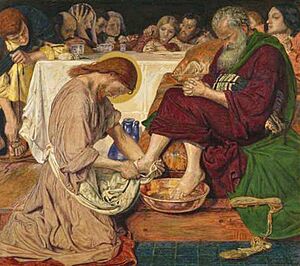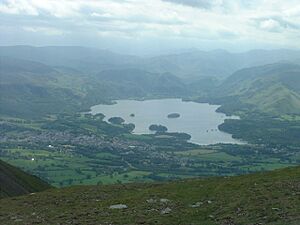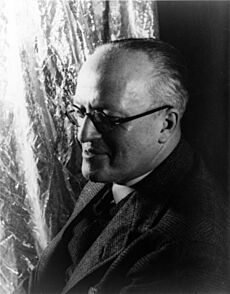Hugh Walpole facts for kids
Sir Hugh Seymour Walpole (born March 13, 1884 – died June 1, 1941) was a famous English writer. He wrote many novels, short stories, and plays. Hugh was the son of a church minister. He was expected to follow in his father's footsteps, but he loved writing instead.
Famous authors like Henry James and Arnold Bennett encouraged him. Hugh was great at describing scenes and creating exciting plots. He was also a popular speaker. This made him very well-known in the United Kingdom and North America. He was a best-selling author in the 1920s and 1930s.
After his first novel, The Wooden Horse, in 1909, Walpole wrote a lot. He published at least one book every year. He was a natural storyteller and wrote quickly. His first big success was his third novel, Mr Perrin and Mr Traill. This book was a sad but funny story about two schoolteachers.
During the First World War, he helped the Red Cross on the Russian-Austrian front. He also worked to spread British information in Russia and London. In the 1920s and 1930s, Walpole was very popular. He was a novelist and also gave many talks about literature. He made four very well-paid tours in North America.
Hugh Walpole lived in the English Lake District for much of his life. He was always looking for what he called "the perfect friend." He was also very kind to younger writers, helping them get started. He loved art and gave many valuable paintings to famous British museums.
Walpole wrote a lot of different kinds of stories. Between 1909 and 1941, he wrote 36 novels. He also wrote five short story collections, two plays, and three memoirs. His books included scary stories, children's tales, and historical fiction. His most famous historical series was The Herries Chronicle, set in the Lake District. He even worked in Hollywood, writing movie scripts. He had a small acting part in the 1935 film David Copperfield.
Contents
About Hugh Walpole's Life
Early Years and School
Hugh Walpole was born in Auckland, New Zealand, on March 13, 1884. He was the oldest of three children. His father was the Rev Somerset Walpole. His mother was Mildred Helen. In 1889, his father got a job in New York. Hugh and his sister Dorothy had a private teacher. But in 1893, his parents decided Hugh needed an English education.
Hugh was sent to England. His biographer, Rupert Hart-Davis, said these were the unhappiest years of Hugh's life. He first went to a school in Truro. He was lonely but somewhat happy there. Then, in 1895, he moved to Sir William Borlase's Grammar School in Marlow. Here, he was bullied and very unhappy. He later said he felt neglected there.
In 1896, his father found out how unhappy Hugh was. He moved him to King's School, Canterbury. Hugh was happier there for two years. In 1897, his father became a principal in Durham. Hugh moved again to Durham School. He felt alone there too. He spent a lot of time in the local library. He read many novels by famous authors like Jane Austen and Charles Dickens.
Hugh Walpole later wrote about his school days in 1924. He said he was "discontented, ugly, abnormally sensitive, and excessively conceited." He felt that no one liked him. Even though he didn't like his schools, the old cathedral cities of Truro, Canterbury, and Durham made a big impression on him. He used parts of these cities for his fictional city of Polchester in his books.
College and Early Jobs
From 1903 to 1906, Walpole studied history at Emmanuel College, Cambridge. While there, he published his first work. It was an essay called "Two Meredithian Heroes." He met A. C. Benson, a teacher at Cambridge. Benson helped him through a time when his religious beliefs were changing.
Walpole's father hoped he would become a minister. But Hugh no longer believed in the same way. After graduating in 1906, he took a job at the Mersey Mission to Seamen in Liverpool. He called this one of his "greatest failures." He resigned after six months.
In 1907, Walpole worked in Germany, teaching children. In 1908, he taught French at Epsom College. His short time teaching inspired his third novel, Mr Perrin and Mr Traill. Walpole had famous writers in his family, like Horace Walpole. He felt strongly that he should become an author. He moved to London and became a book reviewer for The Standard. He wrote fiction in his free time.
Starting His Writing Career
A. C. Benson was a friend of Henry James. In 1908, Walpole wrote a fan letter to Henry James. They started writing to each other. In 1909, James invited Walpole to lunch. They became close friends. James was very fond of Walpole, like a father figure.
Walpole published his first novel, The Wooden Horse, in 1909. It was about an English family changed by a relative returning from New Zealand. The book got good reviews. His first commercial success was Mr Perrin and Mr Traill, published in 1911. This book is a deep look at a conflict between two schoolmasters. Walpole felt it was his truest book.
The Observer newspaper gave the book a good review. It said the story showed "intolerable tension, of impending disaster." Arnold Bennett, a well-known novelist, admired the book. He became Walpole's friend and helped him improve his writing.
The school in Mr Perrin and Mr Traill was based on Epsom College. The students loved it, but the school leaders did not. Walpole was not welcome at Epsom for many years. In 1914, Henry James wrote an article about young British novelists. He named Walpole as one of the best new authors. This was a great honor for Walpole.
World War I Experiences
When war was coming, Walpole knew his poor eyesight meant he couldn't join the army. He tried to join the police but was turned down. Then he got a job as a journalist in Moscow. He reported for The Saturday Review and The Daily Mail. He visited the front lines in Poland. But some people in England criticized him for not doing enough for the war.
Henry James suggested he return to England. But Walpole was excited. He had just joined the Russian Red Cross, called the Sanitar. He wrote to a friend, "I shall be one of the few (half-dozen) Englishmen in the world wearing Russian uniform."
While training, Walpole learned Russian and wrote a book about Joseph Conrad. In summer 1915, he worked on the Austrian-Russian front. He helped in hospitals and rescued wounded soldiers. He wrote to Bennett, "A battle is an amazing mixture of hell and a family picnic." He also thought, "This is not so bad as it was at Marlow."
In June 1915, Walpole bravely rescued a wounded soldier by himself. For this, he received the Cross of Saint George medal. After his duty, he returned to Petrograd. He kept a diary of the books he read and the shows he saw. He met famous Russian artists and writers. He stayed in Russia until October 1915, then returned to England.
In January 1916, the Foreign Office asked him to go back to Petrograd. They wanted him to lead a bureau to counter German propaganda. Before he left, his novel The Dark Forest was published. It was based on his experiences in Russia and was very well-received.
Walpole returned to Petrograd in February 1916. He worked at the Anglo-Russian Propaganda Bureau. In March 1916, he was sad to hear that Henry James had died. Walpole stayed at the bureau through 1916 and 1917. He saw the February Revolution. He wrote reports for the Foreign Office and got ideas for his books. He started his popular "Jeremy" novels and another Russian-themed book, The Secret City. This book won the first James Tait Black Memorial Prize for fiction.
By late 1917, Walpole left Russia. He missed the Bolshevik Revolution that started that day. He worked for the Department of Information in the Foreign Office. He tried to join the British Army but failed the medical exam due to his poor sight. He continued to work in propaganda until February 1919. For his wartime work, he received the CBE in 1918.
After the War and the 1920s
After the war, Walpole kept writing many books. He also started a very profitable career giving talks about literature. In 1919, he went on his first lecture tour in the US. He was welcomed with enthusiasm. His friendly nature and good speaking skills made him very popular in America. This led to higher fees for his talks and more book sales.
Walpole wrote very quickly and rarely changed his work. His British publishers, Macmillan, hired someone to edit his manuscripts. They corrected spelling, punctuation, and facts. He also wrote ten short stories for The Pictorial Review for a large sum of money.
One of Walpole's important novels from this time was The Cathedral. He worked on it for four years. It tells the story of an arrogant church leader in conflict with others. Critics compared it to Trollope's Barchester Towers. The Illustrated London News called it "a great book."
Walpole loved music. In 1920, he heard a new singer at the Proms and was very impressed. Lauritz Melchior became one of his most important friends. Walpole helped the singer's career. Walpole also attended the Bayreuth Festival in Germany. He met Adolf Hitler there, who was a friend of the festival's host. Walpole later said he both disliked and liked Hitler.
In 1924, Walpole moved to a house near Keswick in the Lake District. His large income allowed him to keep his London flat. But Brackenburn, overlooking Derwentwater, was his main home. The beautiful scenery of the Lake District often appeared in his stories.
At the end of 1924, Walpole met Harold Cheevers. Harold became his close friend and companion for the rest of his life. Harold was a policeman, but he left the force to work for Walpole as his driver. Walpole trusted him completely. Harold was almost always with him and often traveled with him. Walpole bought a house for Harold and his family.
In the mid-1920s, Walpole wrote two well-known scary novels. The Old Ladies (1924) is about a timid old woman who is frightened to death. Portrait of a Man with Red Hair (1925) shows the bad influence of a cruel father. Walpole called it "a simple shocker."
He also continued his children's stories, which began with Jeremy in 1919. He wrote Jeremy and Hamlet (1923) and Jeremy at Crale (1927). Many people felt that the "Jeremy" books showed the real, kind, and understanding side of Walpole. His novel Wintersmoon (1928) was his first love story. It showed a conflict between old traditions and new ideas.
1930 to 1941
By the 1930s, some critics thought Walpole's writing was old-fashioned. His reputation was hurt by a character in Somerset Maugham's 1930 novel Cakes and Ale. The character, Alroy Kear, was a superficial writer. Many people thought he was based on Walpole.
In the same year, Walpole wrote Rogue Herries, a historical novel set in the Lake District. It was very popular. The Daily Mail called it "not only a profound study of human character, but a subtle and intimate biography of a place." He wrote three more books in the series, known as The Herries Chronicle.
In 1934, Walpole went to Hollywood to write the script for a film version of David Copperfield. He liked Hollywood, but he found it boring to write many drafts for the studio. He enjoyed his small acting part in the film. He played the Vicar of Blunderstone, giving a boring sermon. His performance was a success.
The film's success led to another invitation to Hollywood in 1936. He had a lot of free time and wrote a short story and worked on a novel. He eventually wrote the script for Little Lord Fauntleroy. He spent most of his earnings on paintings. He had to do another lecture tour to pay his US taxes.
In 1937, Walpole was offered a knighthood. He accepted, even though he felt he wasn't as great as some other authors who had refused it. He wrote in his diary, "I shall like being a knight."
Walpole still loved adventure in his later years. In 1939, he reported for newspapers on the funeral of Pope Pius XI in Rome. He also covered the election of the new Pope and his coronation. He wrote much of his book Roman Fountain during this time. This was his last trip overseas.
When Second World War started, Walpole stayed in England. He divided his time between London and Keswick. He continued to write quickly. He finished a fifth novel in the Herries series and started a sixth. His health was not good because of diabetes. He overdid it at a fund-raising event in May 1941. He gave a speech after a long march. He died of a heart attack at his home, Brackenburn, at age 57. He is buried in St John's churchyard in Keswick.
His Legacy
Walpole was a very good art collector. Sir Kenneth Clark called him "one of the three or four real patrons of art in this country." He gave 14 works of art to the Tate Gallery and Fitzwilliam Museum. These included paintings by famous artists like Cézanne and Manet.

Walpole's collection also had works by Picasso and Gauguin. After his death, his best artworks were shown in London in 1945.
Walpole earned a lot of money. This allowed him to buy art and old books. He also gave money to younger writers. He was very private about his generosity. But after he died, people found out how much he had helped others. Osbert Sitwell said, "I don't think there was any younger writer of any worth who has not at one time or another received kindness... from Hugh."
In Keswick, where he lived, a part of the town museum was dedicated to Walpole in 1949. It has his manuscripts, letters, paintings, and sculptures.
Hugh Walpole's Works
Walpole wrote many different kinds of books. His fiction includes short stories and novels about growing up, like Mr Perrin and Mr Traill and the Jeremy trilogy. He also wrote scary novels, like Portrait of a Man with Red Hair. He wrote ghost stories, historical family sagas like the Herries chronicle, and even detective stories. He wrote biographies of other writers and screenplays, including David Copperfield.
Who Influenced His Writing?
Walpole's early books were influenced by Henry James. But two other big influences were Anthony Trollope and Fyodor Dostoyevsky. Critics noticed the Trollope influence. One critic said that The Cathedral was a story Trollope might have told. But Walpole told it with "a subtler art" and "charm of style."
Walpole loved Trollope's work, but he felt he was too "twisted and fantastic" to be like Trollope. Another critic, J. B. Priestley, saw a darker, Dostoyevsky-like side in Walpole's writing. He said Walpole had "an unusually sharp sense of evil."
Perhaps the biggest influence on Walpole was Walter Scott. Scott's romantic style is seen in many of Walpole's later books. Walpole loved Scott so much that he wanted to be like him. He collected many of Scott's manuscripts and books. With his Herries stories, Walpole helped make historical novels popular again. The Herries series follows a family in the Lake District from the 18th century to modern times.
How People Saw His Work
Walpole wanted critics to like his work, not just for it to sell well. He hoped to write books as good as those by Trollope, Thomas Hardy, and Henry James. Early in his career, important literary figures often praised him. Virginia Woolf liked his ability to capture small details. Joseph Conrad said Walpole explored human nature with "earnestness."
In 1928, Priestley noted that Walpole was once liked by "highbrow" critics. But then he became very popular, and those critics stopped liking him. Priestley felt that Walpole had fulfilled his early promise as a writer.
However, not all critics agreed. Some thought his Russian characters were too simple. But others praised his understanding of Russian culture. The Observer called The Dark Forest "one of the finest novels of our generation."

Walpole could be sensitive to criticism. When Hilaire Belloc praised P. G. Wodehouse as the best English writer, Walpole took it badly. Wodehouse found this funny. Wodehouse himself was not a big fan of Walpole's quick writing style.
When Walpole died, The Times newspaper said he was just a "workmanlike" storyteller. But T. S. Eliot, Kenneth Clark, and Priestley strongly disagreed. Within a few years of his death, Walpole's books were largely forgotten. Elizabeth Steele, a writer, said his writing wasn't deep enough for the times.
However, Walpole's works have not been completely ignored. The Herries stories have almost always been in print. In 2014, many of his other works were reissued. In 2011, the BBC broadcast a program about Walpole called The Walpole Chronicle. In 2013, a new play based on Rogue Herries was performed in Keswick. This might mean new interest in his books.
Books About Hugh Walpole
Two main books about Walpole's life were published after he died. The first was in 1952 by Rupert Hart-Davis, who knew Walpole. It was considered one of the best biographies of the century.
In 1972, Elizabeth Steele wrote a shorter book about Walpole. It focused on his novels and aimed to show why he was so successful. Steele also wrote an article about Walpole in the Oxford Dictionary of National Biography, which talked about his private life openly.
Images for kids
-
Literary forebears: Horace Walpole and Richard Harris Barham.
-
Henry James and Arnold Bennett, who encouraged the young Walpole
-
Konstantin Somov, with whom Walpole lived in Petrograd
See also
 In Spanish: Hugh Walpole para niños
In Spanish: Hugh Walpole para niños














